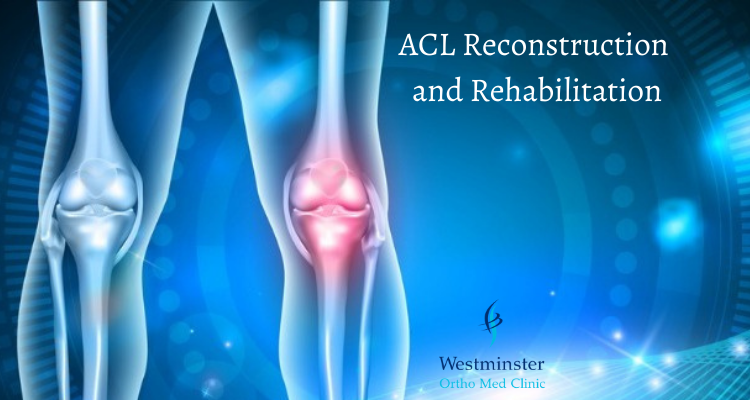The Anterior Cruciate Ligament (ACL) = major stabilizing ligament of the knee. ACL tear does not heal and can result in an unstable knee.
It can be surgically repaired with excellent results – in most cases it will be performed arthroscopically. If wanting to return to sports involving twisting/stepping/change of direction, if you have a physically demanding job or want to maintain an active lifestyle you will have it repaired in most cases. ACL injuries can occur from stepping, twisting, a blow to the knee/leg (such as a tackle) or by falling awkwardly.
Some people can have a good result with conservative management – this will involve completing a good rehab period with a focus on strengthening.
Physiotherapy plays an important role in recovery: Before the operation it will help regain range of motion and strength around the knee. Physiotherapy will then commence shortly after the operation to help settle the knee and improve mobility then will guide your rehab right through to returning to sport or normal activities.
Overall Rehabilitation Plan
The overall rehabilitation plan emphasizes the importance of pre-operative exercises, followed post operatively by early control of swelling and regaining full extension (straightening) and flexion (bending) of the knee. Working on strength can only start once swelling has been controlled and range of movement is nearly normal. Return to function then follows.
The outline that follows is only meant as a guide and there is considerable variation in the specific goals and exercises. It is important to follow the advice of the specific responsible surgeon and rehabilitation team.
Key to Success: Working with your physiotherapist
The key to successful rehabilitation is to regain normal, full straightening of the knee as soon as possible, as well as to control swelling in the early post-operative phase before progressing to strength activities.
For the first six weeks, until the new graft is well bedded in and healed in place, exercises are performed gently with the aim of regaining normal bending and straightening as the swelling settles.
Repetitive cycling of the knee is usually restricted during the first 6 weeks as this may overload the fixation of the ligament and lead to slippage of the graft and effective lengthening of the new ligament.
During exercises the foot is initially kept in contact with the ground or with the surface of an exercise machine these are called ‘closed’ kinetic chain exercises.
Elevation of the leg between exercises to reduce swelling is also important and helps allow the bending to improve.
‘Open’ kinetic chain exercises, where the foot is unsupported, are introduced towards the end of the first six weeks as knee control and strength improve. This allows muscle strength to improve without putting excessive stress on the graft.
General principles for understanding the rehabilitation process
Exercises need to be done 4 – 5 times per day: little and often is better than an extensive overload period. Pain, heat and increasing swelling in the knee are potentially bad: any of these symptoms can mean that exercises are being overdone. This is unlikely to indicate a serious problem, but these symptoms should be discussed with the physiotherapist.
There is a difference between good and bad pain. After major knee surgery the knee will be sore, and it is important to understand that discomfort is normal, particularly when doing some of the stretching exercises. The knee may also ache after an exercise session. This is expected and normal so long as it is not associated with any significant increase in swelling.
‘Bad pain’ is usually sharp and severe in nature. It may be brought on by pushing too hard, and it may be accompanied by an increase in swelling. Activities causing such a problem should be stopped and advice sought from the physiotherapist.
Summary of rehabilitation phases
There are various ways to summarize the phases of rehabilitation and the following is one of the suggested approaches.
There are six main rehabilitation phases and example exercises for each phase are given in the sections that follow. Many different exercises are available to achieve the goals, and these are tailored to each individual by the physiotherapy team.
- Phase 1: Preoperative preparation/operative period
- Phase 2: Initial Post Op Phase
- Phase 3: Proprioception (sensory awareness) Phase
- Phase 4: Strength Phase
- Phase 5: Early Sport Training
- Phase 6: Return to Sport
Specific follow-up assessment: Outpatient review takes place at variable time periods depending on local facilities and surgeon preference.
Work advice and expectations
To expect to be able to return to work as follows:
- Desk work at 3 – 4 weeks
- Light manual work at 6 weeks
- Heavy manual work (ladder work etc) at 3 – 4 months.
Driving advice and expectations
- To expect to return to driving at 3 – 4 weeks depending on knee function.
All of these timescales are an approximate guide and can differ on a patient by patient basis.
Should you require additional information or would like to make an appointment with our Consultant Orthopedic Surgeon Dr. Ishrat Khan OR Physical Therapists, Anil Daniel, OR Hadel Radwan please call us or e-mail us at info@tawamhospital.com
Reference:
- yourphysio.org.uk
Disclaimer: All contents on this site are for general information and in no circumstances information be substituted for professional advice from the relevant healthcare professional, Writer does not take responsibility of any damage done by the misuse or use of the information.


Comments
Ustvarite osebni racun
BryantFlado
Carlosshunc
Stevenecoft
Raymondreinc
buy-ads-account.click_Doorb